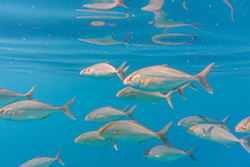Diversification is key to boosting EU’s aquaculture sector
According to the EU-funded DIVERSIFY project, European aquaculture employs 190 000 people and has a EUR 7 billion ex-farm value. But only 10 % of the seafood eaten by consumers in the bloc is actually generated within the EU. The greater amberjack (Seriola dumerili) is a species that could help boost this percentage given their large size, their fillet yield, the short time to market and suitability for product diversification and development of value-added products. These potential benefits are offset by a key challenge: inconsistent reproduction in captivity is preventing efficient marine cage farming of the species. Developing a deeper understanding of what the causes are, could help the EU improve production technologies, diversify products and enhance marketing aspects to boost the growth of the aquaculture industry. The DIVERSIFY (Exploring the biological and socio-economic potential of new/emerging candidate fish species for the expansion of the European aquaculture industry) project is doing just this and a paper recently published in the ‘American Society of Animal Science’ set out some of the team’s latest findings. What is holding up the farming of the greater amberjack? The researchers built on recent studies, which have found that that greater amberjack confined in sea cages exhibited scarce gonad development and early interruption of gametogenic activity, (the formation or production of gametes), during the reproductive season. The result is the impairment of spermatogenesis and so a lower reproductive rate. Adult wild and captive-reared males were sampled during 3 different phases of the reproductive cycle: early gametogenesis (late April to early May), advanced gametogenesis (late May to early June), and spawning (late June to July). The sperm quality of captive-reared fish was evaluated using computer-assisted sperm analysis and the project found captive-reared males exhibited seminiferous lobules of a smaller diameter. The lobules are located within the testes, and are where the male gametes, namely spermatozoa, are created. The captive fish also showed an early and progressive decrease in spermatogonial mitosis and a high level of apoptosis (cell death) right at the start of the reproductive season. These characteristics are in keeping with a higher level of estradiol in the fish’s plasma. In addition to these barriers to rates of reproduction more in line with the captives’ wilder relations, throughout the reproductive season the sperm that was produced showed a drastic decrease in motility, duration, velocity and adenosine triphosphate (APT). Sperm swimming velocity appears to be strongly influenced by sperm morphology, i.e. the size and shape of sperm components: the head, midpiece and flagellum. Sperm with long flagella, and consequently a long total length, tend to have relatively high swimming velocity. The midpiece contains mitochondria, which produce chemical energy in the form of APT. The reduction in APT could be impacting of the sperm’s motility. When it came to the spawning phase, an abnormal increase of sperm concentration as well as an increase of dead spermatozoa occurred, probably because of lack of sperm hydration and ejaculation and consequent sperm ageing. The DIVERSIFY project aims to revolutionise scientific techniques and methodologies to optimise the rearing and production of new finfish species, and to establish the necessary marketing techniques to attract consumers. As the project says, ‘The present study demonstrates the extreme susceptibility of greater amberjack to rearing stress, and underscores the need for improvement of the rearing and handling procedures to ameliorate gametogenesis dysfunctions in commercial aquaculture production.’
Countries
Greece



